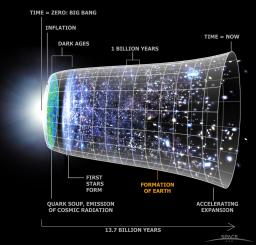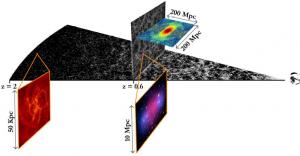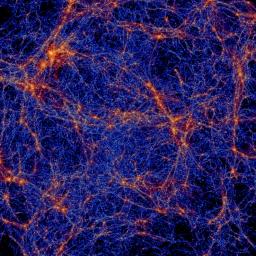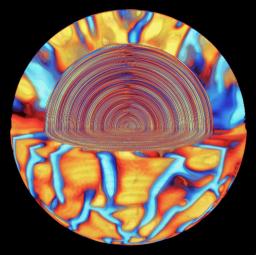Studying the structuration of the Universe consists in studying how galaxies, galaxy clusters, stars and planets form and evolve. The starting point of the structuration of the Universe is well known: the tiny inhomogeneities in the diffuse cosmological background, as observed by WMAP and more recently by Planck. The theoretical framework of the studies is the so-called “cosmological concordance model”, with its two components: dark energy and dark matter. Then, observing the structuration of the Universe is also a way to test the cosmological model. Structuration of the Universe and observational cosmology are strongly interleaved. The studies are made from multi-wavelenghts observations and multi-scales numerical simulations.
The most intriguing development in modern cosmology is to realise that the better part of the Universe is essentially of unknown nature. This conclusion relies on two types of observations. The first one is the indirect evidence since decades of the presence of a large quantity of invisible matter, called dark matter, whose gravitational influence spans all cosmic scales, from galaxy to clusters of galaxies, and the whole Universe. The second one is the observation of an acceleration of the expansion of the Universe in the recent history, which implies the existence of a new concept, a dark energy that exerts a negative pressure opposing the gravitational attraction of matter.
The Standard Model of Cosmology, ΛCDM, accounts for all observations thanks to only six cosmological parameters, which are now precisely known in particular thanks to the results of the Planck satellite. Within this model, the Universe is close to the critical density. Dark energy is described as a cosmological constant and represents about 70% of the energy content of the Universe ; dark matter is cold, i.e. non-relativistic, and represents another 25% ; what is left, less than 5%, is ordinary matter as we know it (gas clouds, stars, planets, etc.).
Understanding the Dark Universe (the nature of dark energy and dark matter) is arguably the greatest challenge of modern physics.
Today our Universe is made up of stars, galaxies, clusters of galaxies but also huge voids. Yet when it was born over 13 billion years ago, matter was evenly distributed.
To understand the physical mechanisms responsible for this scenario, we need to trace the history of galaxies and their clustering by combining the three pillars which are observations, theoretical data modelling and numerical simulations.
This synergy covers a wide range of spatial scales and physical processes :
- from the physics of the interstellar medium to large-scale cosmological structures and wavelength domains;
- from far infrared to X-rays.
At high energies, the violent phenomena of the Universe are linked to the production of radiation and particles such as X-rays, gamma rays, subatomic particles of all types (charged particles, neutrinos, etc.) and to the extreme th gravitational radiation.
The aim of studying this radiation is to understand what mechanisms are capable of producing the acceleration of galactic and extragalactic particles within compact objects and their environment. Researchers are studying black holes (black holes in the centre of the Milky Way, in galactic binary systems or in active galaxies), supernova remnants, pulsars or gamma-ray bursts.
We are studying how stars work, the Sun first of all. We have deepened our knowledge of the Sun via helioseismology observations (discovery of global gravity modes with SOHO-GOLF (Garcia et al., Science 316, 1591 (2007)) and large magneto-hydrodynamics simulations on massively parallel computers (Brun et al. ApJ, 742, 79). The link between the Sun and other stars has been made through our participation in the exploitation of asteroseismology data obtained by the Kepler and Corot missions and state-of-the art simulations of stellar dynamos, activity and cycles (Augustson et al. 2013, 777, 153). We are developing the field of interactions (magnetic, tidal forces) between the stars and their environment (planet, wind, circumstellar envelope; Mathis et al. 2013, Lect. Notes. Physics, 861, 255; Pinto et al. 2011, ApJ, 737, 72).
The Saturn system serves as a detailed laboratory to study the gravitational processes at work in planet formation and circumstellar discs. Exploiting Cassini observations, we have developed an original theory of formation and evolution of Saturn satellites (Charnoz et al. Nature 465, 752 (2010)), which only works if the tidal force between Saturn and its satellite is 10 times higher than usually considered. Confirmation of the strong tidal force has been obtained through precise astrometric measurements of the motion of Saturn satellites (Lainey et al., ApJ 752, 19 (2012)). Such a strong tidal force can be reproduce by the new model of Remus et al. (A&A 541, A165 (2012)).
see the homepages : - "Laboratory Dynamics of Stars and their Environment"
- "Star and Planet Formation Laboratory"








